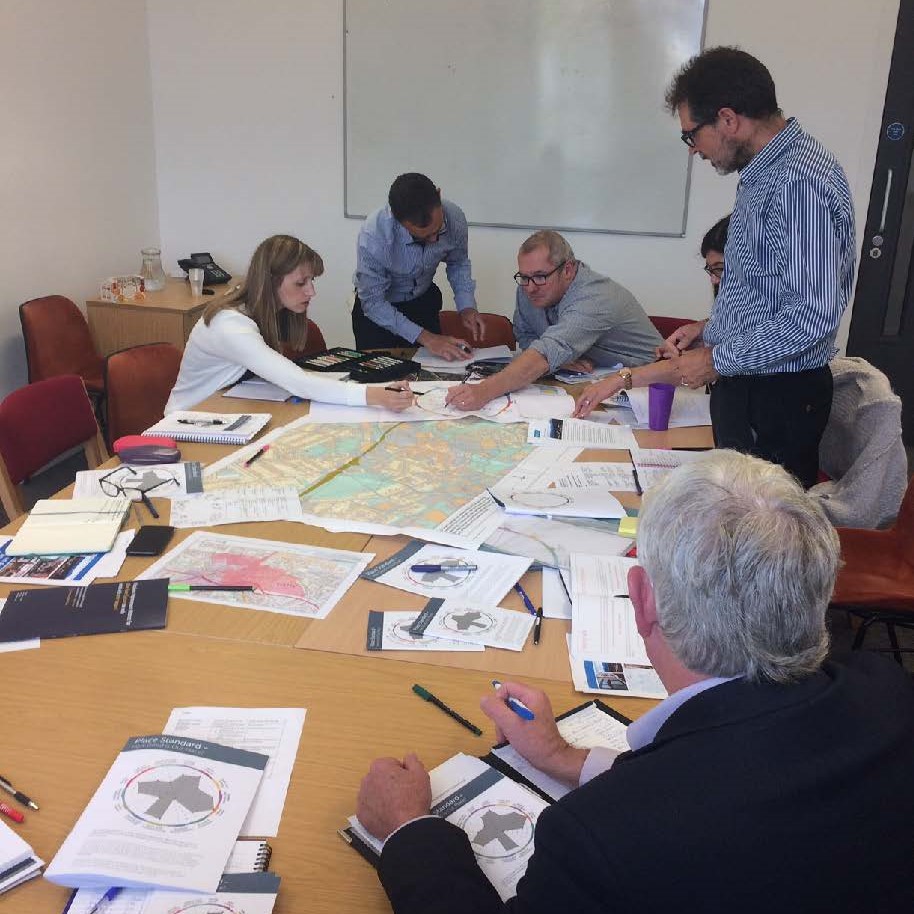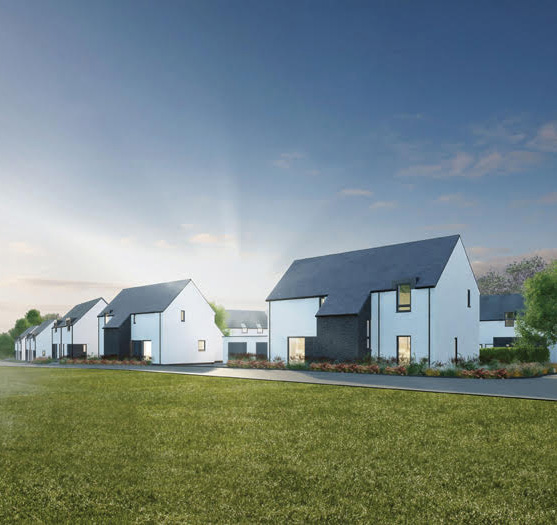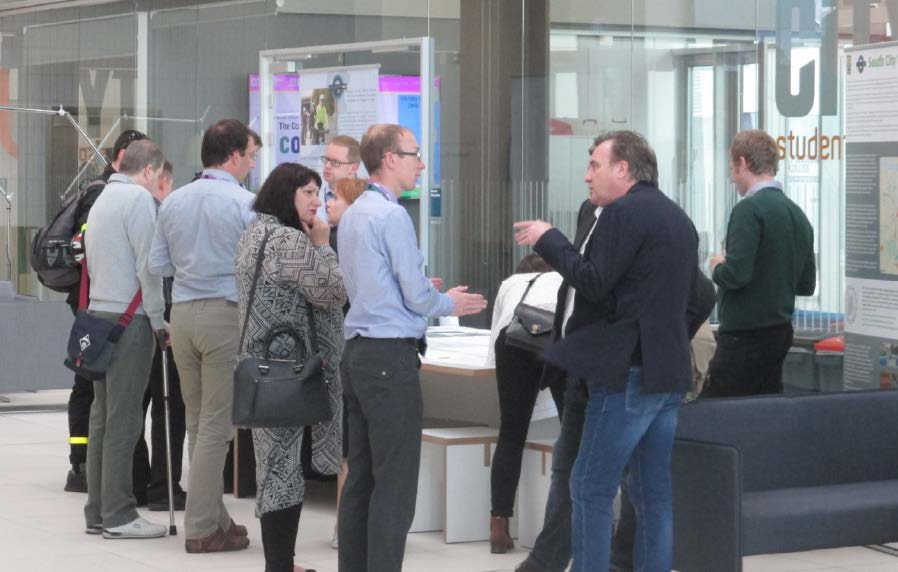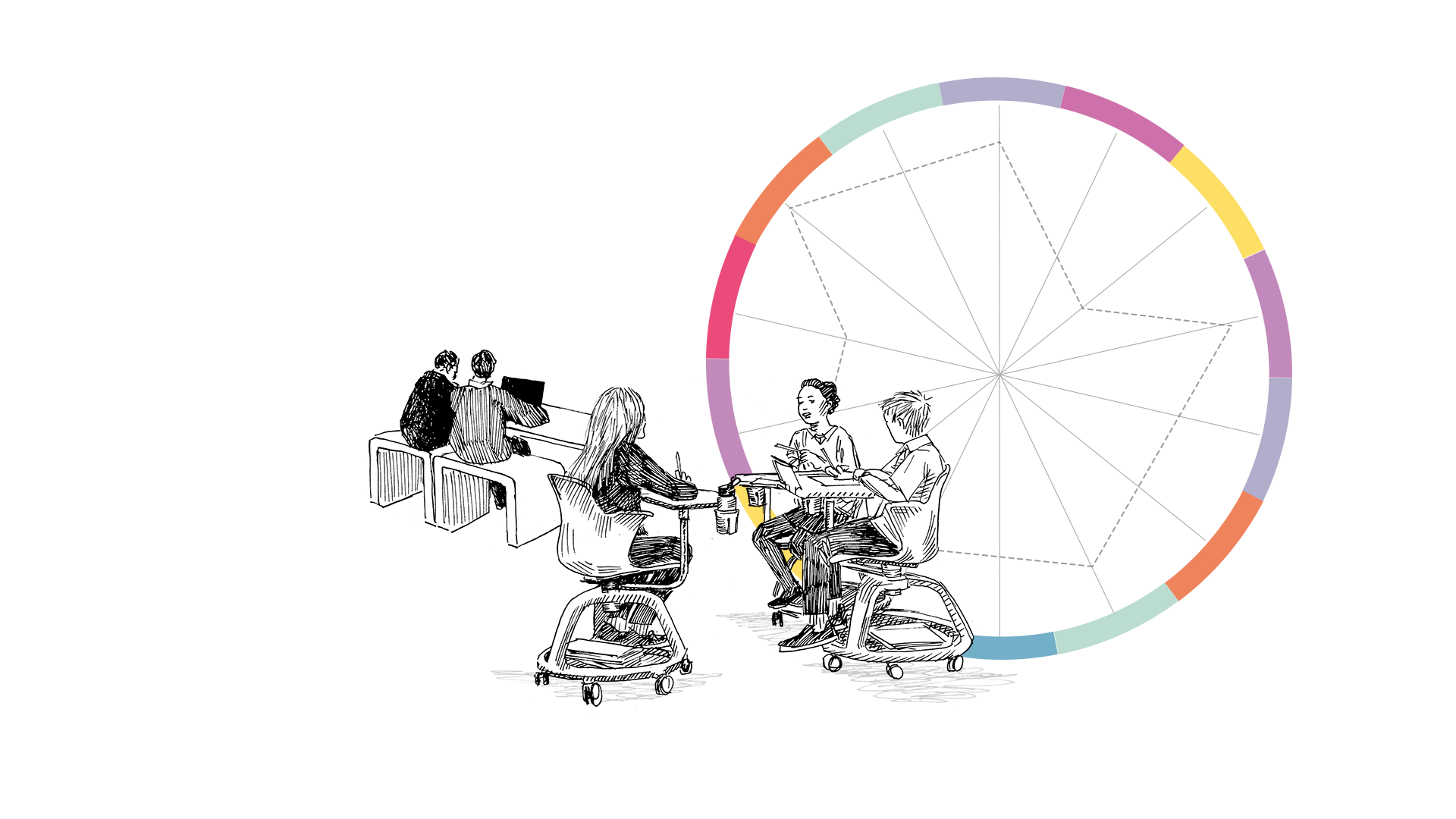There are a variety of factors to consider for developers and investors getting involved in planning, designing, and creating places across Scotland. From identifying community views to assessing proposals, the challenges that arise can be helped by using the Place Standard tool.
The Place Standard tool provides developers and investors with a simple framework. It enables you to gather evidence from discussions across multiple groups and individuals, by considering the physical and social environments of a place.
How is the tool relevant?
- Provides baseline data for investment planning and site assessments
- Collects evidence of local needs
- Provides design team brief
- Tests capacity of prospective housing sites
How can the tool help resolve current issues for place-based work?
- Housing development business planning
- Housing masterplanning
- Regeneration Planning
- Town centre action planning
- Active travel infrastructure planning
Real-life examples of the Place Standard tool in action
We have collected a series of case studies that provides evidence of how the Place Standard tool can benefit developers and investors. These case studies are a recollection of stories from the local authorities, organisations, and designers' point-of-view of using the Place Standard tool.
Read the case studies below to learn about collaborative and place-based approaches to projects across Scotland.
Click on the links to scroll to the selected case study.

Multi-generational housing and town centre investment in Alloa
Over the coming years, Clackmannanshire Council (CC) and the Business Improvement District (BID) body Alloa First, are delivering improvements to the town centre of Alloa.
Partner organisations, CC and Clackmannanshire Third Sector Interface (CTSI) share their experience of applying the Place Standard to facilitate professional collaboration and community consultation—informing housing design and town centre investment in Alloa.
Image credit: Clackmannanshire Council
The process was motivated by concerns (including from local politicians) about whether the town centre would make an appropriate place for the ageing population and those with dementia to live.
Perceived problems included anti-social behaviour, quality of the street environment and non-car accessibility.
Our process involved two stages, the first being stakeholder focus group and a second carrying out major public consultation to inform the masterplan.
Stage 1
The first stage of stakeholder focus group examined the issue and made sure dementia design was placed front and centre.
We engaged with A&DS at the earlier design stage as we felt the site needed a design process that raised the bar beyond previous schemes. The site is in the conservation area and next to an A-listed public building.
Stage 2
At the second stage, we carried out a major public consultation to inform a new town centre masterplan or place plan as part of the local development plan review.
This was also designed to inform local infrastructure improvements, community services planning and social care. We were hoping for a greater breadth and depth of input than we had previously achieved from public consultation exercises.
We felt the Place Standard was the best tool for giving us a full understanding of what people felt about Alloa town centre before we started drafting any plans.
Stage 1 – Council member focus group
A&DS and the Scottish Government facilitated the first focus group from August to October 2018. In this group, they involved a group of officers from CC across a range of services which included:
- health and social care professionals
- architects
- housing association representatives
- town centre business representatives
Using the tool, they looked at town centre assets and the improvements required; to provide for the needs of elderly residents of the new housing proposed at Primrose Street and the wider Alloa community.
The session was carried out as a focus group over two hours—with the quality of discussion, level of engagement and an incomplete compass prompting a second group session to complete the tool.
By the close of this session, there was agreement amongst partners that community engagement was also necessary.
Stage 2 - Public consultation
In early 2019, the consultation involved a broad cross-section of around 300 Alloa residents using the Place Standard assessment.
Project partners highlighted the importance of active participation from the community for the consultation—resulting in the Scottish Governments support of granting the Place Standard Conversations fund.
CC launched and publicised the online tool with a press release and link from the council website, with partners CTSI and Alloa First following suit.
CTSI spent time connecting with specific target groups to ensure they were a representation of diverse groups in the consultation period. This included local disability groups, racial, minorities, younger people, and the ageing population.
The combination of targeting specific groups, public drop-in sessions, and publicising the online tool helped to achieve a wide and diverse response. Some of these included:
- Older Adults Forum
- Volunteer Manager Forum
- KLACKSUN mental health group
- Senior learners from Alloa Academy
Improving streetscape
The A&DS-facilitated Place Standard focus group helped identify priority streetscape improvements, reinforced by the stage two community results. The streetscape works would make the town centre a safer, friendlier place for people with dementia and everyone.
Real-time design feedback
Due to the timescale for the Primrose Street planning application, the inputs from the focus group helped shape the evolving development design in real-time during the pre-application stage. The planning application had a smooth passage, meeting well within statutory performance targets.
Informing masterplans and place plans
The stage two public consultation results informed the development of a masterplan and Place Plan for Alloa town centre. The main issue report on the new local development went to the council in December 2019. Following this, additional consultation stages and events will check and test decisions as the local development plan develops.
Facilitating funding decisions
The Place Standard survey results from both stages have also facilitated rapid funding decisions. In March 2019, Clackmannanshire Council was awarded £683,000 from the Scottish Government’s £50 million Town Centre Fund Capital Grant. Thanks to the Place Standard consultations, the council could identify and approve other suitable projects in Alloa town centre.
Further collaboration between CC, Alloa first and CTSI
The delivery of an active travel hub project and regular meetings between planning officers with Alloa First to provide support on:
- signage
- branding strategy
- facilitating open air markets
- promoting Alloa more widely
Town centre living
The council community services team is now working closely with the Kingdom Housing Association regarding the Speirs Centre. They're aiming to ensure the community makes the most out of the centre as a resource and meeting place for residents of the new flats.
The success of the Place Standard consultation enabled further collaboration between A&DS and the Scottish Futures Trust. A collaboration involving the use of Clackmannanshire as a pilot area for rolling out the ‘A Caring Place’ approach to intergenerational town centre housing.
The council has also had success with the Place Standard in Alva as part of their streetscape plans. A&DS helped the community council lead a Place Standard consultation, including a 3-day drop-in where volunteers were on hand to discuss and assist.
Empowering the community showed how the use of the tool can help make the whole process more constructive, collaborative, and beneficial in terms of feedback.
Empowering community groups and members
CTSI is also using the results to help focus its efforts and actions more effectively. Part of their work on the project was to equip community groups to feel informed and confident enough to use the Place Standard tool in their own setting.
The tool has now been used to inform the new Community Action Plan for Alloa South and East. Beyond the Alloa consultation, CTSI has used the Place Standard tool in its Community Justice Partnership to engage vulnerable people in a conversation around how they feel about their place.
“The strength of the Place Standard tool is that it can be used in so many different settings and at various scales – be it street, town centre or even wider. It provides a more focussed and structured engagement with people, moving beyond simply the airing of grievances. It allows people to structure their thoughts on particular issues and (dare I say it), even be positive.”

Scotia Homes Site Briefs in Angus and Perthshire
Aberdeenshire-based housing developer Scotia Homes uses the Place Standard tool internally at start of each new project.
Speaking to Jonathan Wisely, Development lead/Architect for Scotia Homes, he explains how the team uses the tool to establish their development briefs.
Image credits: Scotia Homes
At Scotia Homes, the use of the Place Standard tool has been built into our project management process since its launch in December 2015. Before that, Scotia had its own ‘Place o’ Meter’ tool.
The Place Standard tool is applied internally at the outset of all new projects—before any local authority input and public consultation—to guide design briefs for new housing sites. We also used the tool on a new site of 100 homes in Forfar, Angus, and a rural site for 92 new homes near Bridge of Earn, Perthshire.
The tool helps inform our design development brief for each new project to produce a benchmark ‘vision’ of the place we are trying to create. We then use this vision to facilitate decision-making and review against it at key stages of the development.
Gathering information
Usually, two to three members of our in-house design team complete the online version of the tool in the office—to help generate and inform the design brief for the proposed new housing development.
Staff members also use a combination of desk research and site visits, gathering information that considers existing local amenities to identify needs—within the proposed new development and community—when completing the exercise.
Sharing results
They generally complete the tool individually and then discuss their scores to reach a consensus, added online to produce the Place Standard wheel diagram.
The resulting wheel is included in the initial briefing document which goes out to external design consultants.
Comparing project development and initial results
As the design evolves and the project develops—with input from the design team, external consultants, local authority, and others—we then benchmark the progress against the initial Place Standard results.
Clarifying aspirations and proposals
Using the tool internally in this way has helped to clarify our aspirations for our proposed new housing sites when drawing up design briefs.
Facilitating decision-making
The tool has helped us facilitate decision-making on local needs to prepare design team briefs.
Meeting initial development aspirations
The results of the Place Standard exercise feeds into the design brief document, then referred to as a way of ensuring the design development meets the initial development aspirations.
Crucially, the use of the Place Standard tool is embedded as part of our project management procedure for every site.
“The Place Standard has proved to be a useful tool with regard to tracking design development, and aids with the brief development at the outset of a project.”

Glasgow Active Travel Investment planning and design
Sustrans Scotland uses the Place Standard tool for its funding delivery model on large active travel infrastructure projects in Scotland.
Speaking with Mathew MacDonald, Head of Infrastructure and Stewart Inglis of the sustainable transport charity, they explain how the Place Standard tool helps them inform investment decisions to a new cycleway project in Glasgow.
Image credit: Sustrans Scotland
We use the Place Standard tool in one of our funding delivery models, Community Links PLUS. It's a design competition for big, innovative infrastructure projects that transform streets in favour of people moving about under their own steam.
Our aim for these projects is to deliver sustainable transport corridors, holistic placemaking and public realm improvements and enhance the local economy.
As an organisation, we were keen to support the use of the Place Standard. We felt that it would be a valuable addition to the competition process—both as an engagement tool and to enhance project designs. It benefits us as:
- an engagement tool to help understand how the community feels about the location of the proposed project
- a design tool to help enhance project designs by feeding into concept ideas
- a benchmarking tool to inform funding decisions as our panel has access to reports and outputs to weigh proposal against them
Assessment process through workshops
Community Links PLUS projects use the Place Standard tool in engagement as part of an extensive three-stage assessment process.
Competition applications gather community representatives and stakeholders in a workshop setting to assess project locations.
Training and upskilling
We recognised the importance of using the tool correctly and provided training for competition applicants through members of the Place Standard Alliance.
The training has added benefits of upskilling applicants, enabling them to use the Place Standard in their future work.
Improving town centres with Place Standard
The winner of the inaugural design competition, held in 2015-16, was Glasgow City Council’s South City Way, forecast for completion in autumn 2019.
The project will also improve facilities for those on foot, creating more vibrant streets and improving the look and feel of the area. For more information, visit Glasgow.gov.uk.
Consultation events
Glasgow City Council used the Place Standard as part of a wider consultation event with the community and other stakeholders—staged at the City of Glasgow College Riverside Campus in May 2016.
This event fed into the council’s South City Way submission for the third and final stage of the competition.
Considering the needs and wants of the community
There was plenty of discussion around design details and features in the Place Standard workshop for South City Way. It highlighted focus areas for the project and the content of the final competition submission, including:
- factoring in future developments in the project area
- maximising placemaking opportunities
- highlighting the interaction of walking and cycling infrastructure with public transport services and parking
- supporting the ongoing regeneration efforts in the area
A focus on regeneration efforts
Central to the discussion was the importance of supporting the ongoing regeneration efforts in the area.
As past planning and policy decisions had been ill-conceived, the discussions also stressed the importance of making good decisions for the future.
Reviewing and monitoring results
Once a project goes through the process of funding to completion, we'll be able to go back in with the original cohort group. By bringing together those groups from the initial Place Standard exercise, we can see what the perception of the place is post-construction.
Once a project goes through the process of funding to completion, we'll be able to go back in with the original cohort group. By bringing together those groups from the initial Place Standard exercise, we can see what the perception of the place is post-construction.
As well as enabling us to understand the impact of the South City Way, this will contribute to monitoring and evaluating the overall effectiveness of Community Links PLUS as a funding delivery model.
“We feel that the Place Standard has been a very useful tool for informing the iterative design process. At Sustrans Scotland, we recognise the need for deep, meaningful community engagement, and this is an excellent tool for providing a structured dialogue with the community.”

North Staneyhill, Lerwick Housing masterplan
The two design partners, Paul Morsley, Director of Iglu Studio and Ian Malcomson, Director of Malcomson Architects, share their joint experience of using the Place Standard to inform the masterplan for the site.
Image credit: Robert Witanski on Unsplash
In 2015, Hjaltland Housing Association (HHA) acquired a site on the north side of Staneyhill in Lerwick, aiming to develop up to 350 new affordable homes over ten to 15 years.
Due to the complexities of the hillside location, the HHA commissioned a masterplan to achieve a vibrant, safe and desirable place to live, that also took into account the needs of the surrounding community.
To inform this masterplan, HHA’s appointed design partners to run a consultation exercise with the existing adjacent community, involving local people in the design process in a very focussed, site-specific way. Iglu Studio brought to the project its earlier experience of using the Place Standard tool in design charrettes.
Promoting community consultations events
The team conducted community consultations in two phases in 2016. The first in May and June, followed by the second in December. The events were promoted through:
- a dedicated website
- social media
- leaflets
- local press
- broadcast media
The events were also open to all residents – those local to the immediate area and the people of wider Lerwick.
Phase one
Phase one introduced the project and sought suggestions for the new development. The team used the Place Standard tool during this phase to provide an understanding of how residents felt about the existing Staneyhill area.
What was involved?
- Pre-consultation discussions and presentations held at Lerwick Community Council and Staney Hill Community Association meetings.
- Distributing a questionnaire based on the Place Standard tool online, in exhibitions and to 600 households in the immediate vicinity.
- An exhibition on the proposed project held at two nearby shopping centres.
- Two hour-long sessions in May and June 2016, of participants working in groups completing paper versions of the tool.
- A consultation event held at Anderson High School for learners to fill out.
Phase two
Phase two focused on gauging public reaction by gaining feedback on the design team's outline proposals, based on comments and results from the Place Standard exercise in phase one.
What was involved?
- Gathering public views through Place Standard based questionnaires, post-it notes and conversations with the design team.
- An afternoon public drop-in session at Staney Hill Hall with proposals on display boards and video of the site attracted over 65 residents.
- Public workshop in the evening at Staney Hill Hall.
A further public presentation took place in late 2017, in preparation for the adoption of the Masterplan as Supplementary Guidance associated with the Shetland Local Development Plan.
Identifying issues of concern from the community
Phase one highlighted significant concerns which provided core principles to guide the masterplan. These included:
- a lack of existing amenities
- access to open space
- waymarking of pedestrian routes
- off-street parking
- links to the city centre
- types of existing housing
- road layout
- drainage / flood management
For the design team, it was enormously valuable to gain residents’ insights and pick up on detailed concerns that proved helpful in the next stage of design. The comments received and discussions held helped the team to understand the community’s aspirations for the new development.
Honest and open feedback
Using the Place Standard over two phases—with the first focused on the existing site without any development proposals—meant that feedback was honest and open about the site.
This gave the design team a foundation against which ideas and proposals could be assessed and adjusted from the beginning.
Identifying principles of the masterplan
The second use of the tool, set against an early draft of the masterplan, allowed the core underlying principles of the masterplan to be reviewed and discussed without too much focus on the detail.
With the masterplan considering local residents’ views from the first phase, the principles were more readily accepted at the second phase event.
The exercise identified how the proposed masterplan responded to the priorities and needs of the existing community:
- safety for children
- a focus on housing
- a need for substantial open space for play and recreation and community use
- safe traffic management
- provision for getting around on foot and by bike
Providing supplementary guidance
The final production of the exercise included the masterplan and three Development Framework books. Since then, the Shetland Islands Council (SIC) have adopted the masterplan and codes/parameters as supplementary guidance.
Prospects of further collaboration
Since the North Staneyhill community consultation, Iglu has been working with SIC on further projects using the Place Standard tool, as well as with Planning Aid for Scotland (PAS) on several other community engagement projects which use the Place Standard tool.
“The Place Standard tool was a new experience for our design team and was very easy for us and the community to understand quickly. This made the public consultation a more meaningful experience for everyone.”
Apply the Place Standard tool to your needs
We can help you start your journey of applying the place standard tool to your development and investment opportunities. From learning resources to workshops with key stakeholders, let us guide you in the right direction of gaining invaluable insight to shaping your places.

